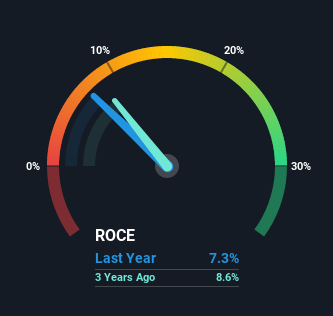- Sweden
- /
- Trade Distributors
- /
- OM:BERG B
Some Investors May Be Worried About Bergman & Beving's (STO:BERG B) Returns On Capital

What underlying fundamental trends can indicate that a company might be in decline? More often than not, we'll see a declining return on capital employed (ROCE) and a declining amount of capital employed. Basically the company is earning less on its investments and it is also reducing its total assets. So after glancing at the trends within Bergman & Beving (STO:BERG B), we weren't too hopeful.
What is Return On Capital Employed (ROCE)?
For those who don't know, ROCE is a measure of a company's yearly pre-tax profit (its return), relative to the capital employed in the business. The formula for this calculation on Bergman & Beving is:
Return on Capital Employed = Earnings Before Interest and Tax (EBIT) ÷ (Total Assets - Current Liabilities)
0.073 = kr256m ÷ (kr5.0b - kr1.5b) (Based on the trailing twelve months to September 2021).
Therefore, Bergman & Beving has an ROCE of 7.3%. In absolute terms, that's a low return and it also under-performs the Trade Distributors industry average of 16%.
Check out our latest analysis for Bergman & Beving

In the above chart we have measured Bergman & Beving's prior ROCE against its prior performance, but the future is arguably more important. If you'd like, you can check out the forecasts from the analysts covering Bergman & Beving here for free.
What Does the ROCE Trend For Bergman & Beving Tell Us?
We are a bit worried about the trend of returns on capital at Bergman & Beving. Unfortunately the returns on capital have diminished from the 10% that they were earning five years ago. Meanwhile, capital employed in the business has stayed roughly the flat over the period. Since returns are falling and the business has the same amount of assets employed, this can suggest it's a mature business that hasn't had much growth in the last five years. So because these trends aren't typically conducive to creating a multi-bagger, we wouldn't hold our breath on Bergman & Beving becoming one if things continue as they have.
The Key Takeaway
In summary, it's unfortunate that Bergman & Beving is generating lower returns from the same amount of capital. Investors must expect better things on the horizon though because the stock has risen 39% in the last five years. Either way, we aren't huge fans of the current trends and so with that we think you might find better investments elsewhere.
One more thing to note, we've identified 2 warning signs with Bergman & Beving and understanding them should be part of your investment process.
If you want to search for solid companies with great earnings, check out this free list of companies with good balance sheets and impressive returns on equity.
Valuation is complex, but we're here to simplify it.
Discover if Bergman & Beving might be undervalued or overvalued with our detailed analysis, featuring fair value estimates, potential risks, dividends, insider trades, and its financial condition.
Access Free AnalysisThis article by Simply Wall St is general in nature. We provide commentary based on historical data and analyst forecasts only using an unbiased methodology and our articles are not intended to be financial advice. It does not constitute a recommendation to buy or sell any stock, and does not take account of your objectives, or your financial situation. We aim to bring you long-term focused analysis driven by fundamental data. Note that our analysis may not factor in the latest price-sensitive company announcements or qualitative material. Simply Wall St has no position in any stocks mentioned.
Have feedback on this article? Concerned about the content? Get in touch with us directly. Alternatively, email editorial-team (at) simplywallst.com.
About OM:BERG B
Bergman & Beving
Provides solutions for the manufacturing and construction sectors in Sweden, Norway, Finland, and internationally.
Proven track record with adequate balance sheet.

